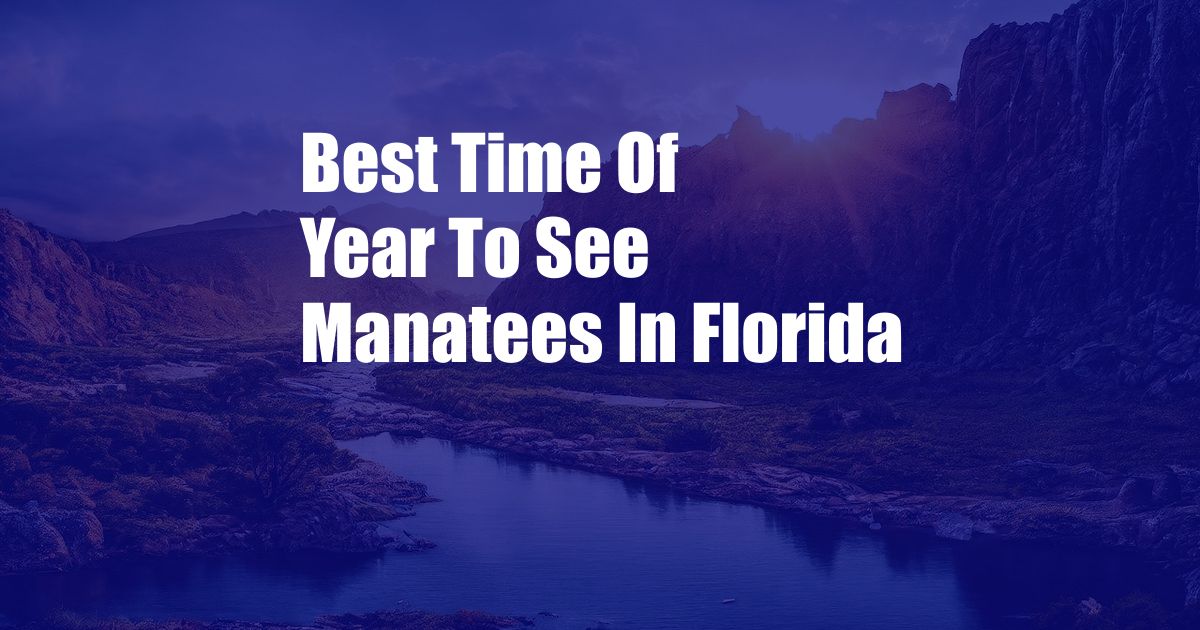
The Ultimate Guide to Witnessing the Majestic Manatees in Florida
As I strolled along the turquoise waters of Crystal River, a gentle nudge from beneath the surface caught my attention. I peered into the crystal-clear water and gasped in delight as a massive manatee, its sleek gray body glimmering in the sunlight, swam lazily towards me. This remarkable encounter sparked within me a deep fascination for these gentle giants and a burning desire to share their story with the world.
Florida, with its warm waters and abundant seagrass beds, has long been a haven for manatees. These aquatic mammals, lovingly known as “sea cows,” captivate visitors with their curious nature and gentle demeanor. Embarking on a manatee-viewing expedition is not merely an activity but an unforgettable experience that will leave an enduring imprint on your heart.
When to See Manatees in Florida
The best time to spot manatees in Florida varies depending on the region. However, the general consensus is that the winter months, from November to April, offer the most reliable sightings.
During the cooler winter months, manatees seek refuge in warm-water sanctuaries, such as natural springs and power plant outflows. These designated areas provide a comfortable habitat for manatees to congregate and socialize. However, it’s important to note that manatees can be spotted year-round in Florida, albeit in smaller numbers during the warmer months.
Where to See Manatees in Florida
Florida boasts numerous locations where you can witness these gentle giants in their natural habitat. Here are some of the most popular destinations:
- Crystal River: Known as the “Manatee Capital of the World,” Crystal River offers a breathtaking opportunity to swim or snorkel alongside manatees.
- Homosassa Springs Wildlife State Park: This sanctuary provides a protected environment for manatees, and visitors can observe them from underwater viewing platforms.
- Blue Spring State Park: During the winter months, thousands of manatees gather at Blue Spring, a designated manatee refuge.
- Weeki Wachee Springs State Park: At this enchanting park, you can witness manatees up close during a glass-bottom boat tour.
Tips for Manatee Viewing
To ensure a responsible and rewarding manatee-viewing experience, follow these expert tips:
- Observe from a distance: Respect manatees’ space and maintain a minimum distance of 10 feet when viewing them.
- Avoid touching or feeding: Manatees are wild animals, and it’s prohibited to touch or feed them. Any form of interaction can disrupt their natural behavior.
- Be patient: Manatees are slow-moving creatures. Allow ample time for them to approach you, and avoid any sudden movements that may startle them.
- Respect their environment: Do not litter or disturb the seagrass beds where manatees feed and rest.
By adhering to these guidelines, you can ensure that future generations will continue to appreciate the beauty and wonder of these majestic creatures.
FAQ on Manatees
What is the average lifespan of a manatee?
Manatees have an average lifespan of 50-60 years.
What is the gestation period for a manatee?
Manatees have a gestation period of 12-14 months.
Are manatees endangered?
Manatees are listed as endangered under the Endangered Species Act, and only around 6,300 individuals remain in the wild.
What are the main threats to manatees?
The primary threats to manatees include boat strikes, loss of habitat, and pollution.
Conclusion
Witnessing the gentle grace of manatees in Florida is an experience that will forever hold a special place in your heart. By embracing responsible viewing practices and sharing their story, we can ensure the well-being of these iconic creatures for generations to come.
I invite you to embark on this extraordinary journey and discover the wonders of manatees in Florida. Let their serene presence inspire you to become an advocate for their protection and conservation. Are you ready to dive into the magical underwater world of manatees?